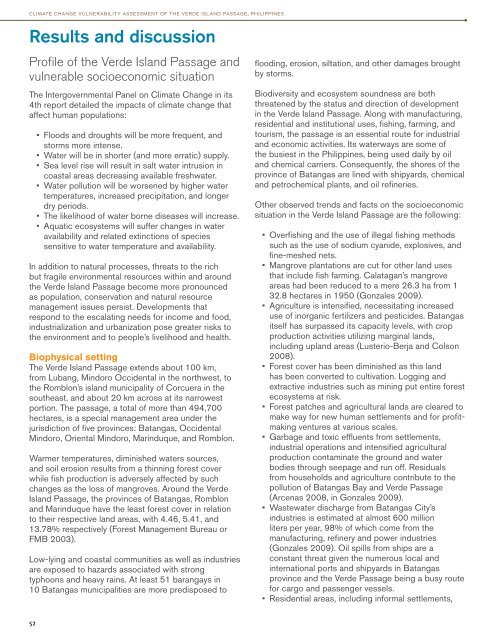of the Verde Island Passage, Philippines - weADAPT
of the Verde Island Passage, Philippines - weADAPT
of the Verde Island Passage, Philippines - weADAPT
You also want an ePaper? Increase the reach of your titles
YUMPU automatically turns print PDFs into web optimized ePapers that Google loves.
climate change vulnerability assessment <strong>of</strong> <strong>the</strong> verde island passage, philippines<br />
Results and discussion<br />
Pr<strong>of</strong>ile <strong>of</strong> <strong>the</strong> <strong>Verde</strong> <strong>Island</strong> <strong>Passage</strong> and<br />
vulnerable socioeconomic situation<br />
The Intergovernmental Panel on Climate Change in its<br />
4th report detailed <strong>the</strong> impacts <strong>of</strong> climate change that<br />
affect human populations:<br />
• Floods and droughts will be more frequent, and<br />
storms more intense.<br />
• Water will be in shorter (and more erratic) supply.<br />
• Sea level rise will result in salt water intrusion in<br />
coastal areas decreasing available freshwater.<br />
• Water pollution will be worsened by higher water<br />
temperatures, increased precipitation, and longer<br />
dry periods.<br />
• The likelihood <strong>of</strong> water borne diseases will increase.<br />
• Aquatic ecosystems will suffer changes in water<br />
availability and related extinctions <strong>of</strong> species<br />
sensitive to water temperature and availability.<br />
In addition to natural processes, threats to <strong>the</strong> rich<br />
but fragile environmental resources within and around<br />
<strong>the</strong> <strong>Verde</strong> <strong>Island</strong> <strong>Passage</strong> become more pronounced<br />
as population, conservation and natural resource<br />
management issues persist. Developments that<br />
respond to <strong>the</strong> escalating needs for income and food,<br />
industrialization and urbanization pose greater risks to<br />
<strong>the</strong> environment and to people’s livelihood and health.<br />
Biophysical setting<br />
The <strong>Verde</strong> <strong>Island</strong> <strong>Passage</strong> extends about 100 km,<br />
from Lubang, Mindoro Occidental in <strong>the</strong> northwest, to<br />
<strong>the</strong> Romblon’s island municipality <strong>of</strong> Corcuera in <strong>the</strong><br />
sou<strong>the</strong>ast, and about 20 km across at its narrowest<br />
portion. The passage, a total <strong>of</strong> more than 494,700<br />
hectares, is a special management area under <strong>the</strong><br />
jurisdiction <strong>of</strong> five provinces: Batangas, Occidental<br />
Mindoro, Oriental Mindoro, Marinduque, and Romblon.<br />
Warmer temperatures, diminished waters sources,<br />
and soil erosion results from a thinning forest cover<br />
while fish production is adversely affected by such<br />
changes as <strong>the</strong> loss <strong>of</strong> mangroves. Around <strong>the</strong> <strong>Verde</strong><br />
<strong>Island</strong> <strong>Passage</strong>, <strong>the</strong> provinces <strong>of</strong> Batangas, Romblon<br />
and Marinduque have <strong>the</strong> least forest cover in relation<br />
to <strong>the</strong>ir respective land areas, with 4.46, 5.41, and<br />
13.78% respectively (Forest Management Bureau or<br />
FMB 2003).<br />
Low-lying and coastal communities as well as industries<br />
are exposed to hazards associated with strong<br />
typhoons and heavy rains. At least 51 barangays in<br />
10 Batangas municipalities are more predisposed to<br />
flooding, erosion, siltation, and o<strong>the</strong>r damages brought<br />
by storms.<br />
Biodiversity and ecosystem soundness are both<br />
threatened by <strong>the</strong> status and direction <strong>of</strong> development<br />
in <strong>the</strong> <strong>Verde</strong> <strong>Island</strong> <strong>Passage</strong>. Along with manufacturing,<br />
residential and institutional uses, fishing, farming, and<br />
tourism, <strong>the</strong> passage is an essential route for industrial<br />
and economic activities. Its waterways are some <strong>of</strong><br />
<strong>the</strong> busiest in <strong>the</strong> <strong>Philippines</strong>, being used daily by oil<br />
and chemical carriers. Consequently, <strong>the</strong> shores <strong>of</strong> <strong>the</strong><br />
province <strong>of</strong> Batangas are lined with shipyards, chemical<br />
and petrochemical plants, and oil refineries.<br />
O<strong>the</strong>r observed trends and facts on <strong>the</strong> socioeconomic<br />
situation in <strong>the</strong> <strong>Verde</strong> <strong>Island</strong> <strong>Passage</strong> are <strong>the</strong> following:<br />
• Overfishing and <strong>the</strong> use <strong>of</strong> illegal fishing methods<br />
such as <strong>the</strong> use <strong>of</strong> sodium cyanide, explosives, and<br />
fine-meshed nets.<br />
• Mangrove plantations are cut for o<strong>the</strong>r land uses<br />
that include fish farming. Calatagan’s mangrove<br />
areas had been reduced to a mere 26.3 ha from 1<br />
32.8 hectares in 1950 (Gonzales 2009).<br />
• Agriculture is intensified, necessitating increased<br />
use <strong>of</strong> inorganic fertilizers and pesticides. Batangas<br />
itself has surpassed its capacity levels, with crop<br />
production activities utilizing marginal lands,<br />
including upland areas (Lusterio-Berja and Colson<br />
2008).<br />
• Forest cover has been diminished as this land<br />
has been converted to cultivation. Logging and<br />
extractive industries such as mining put entire forest<br />
ecosystems at risk.<br />
• Forest patches and agricultural lands are cleared to<br />
make way for new human settlements and for pr<strong>of</strong>itmaking<br />
ventures at various scales.<br />
• Garbage and toxic effluents from settlements,<br />
industrial operations and intensified agricultural<br />
production contaminate <strong>the</strong> ground and water<br />
bodies through seepage and run <strong>of</strong>f. Residuals<br />
from households and agriculture contribute to <strong>the</strong><br />
pollution <strong>of</strong> Batangas Bay and <strong>Verde</strong> <strong>Passage</strong><br />
(Arcenas 2008, in Gonzales 2009).<br />
• Wastewater discharge from Batangas City’s<br />
industries is estimated at almost 600 million<br />
liters per year, 98% <strong>of</strong> which come from <strong>the</strong><br />
manufacturing, refinery and power industries<br />
(Gonzales 2009). Oil spills from ships are a<br />
constant threat given <strong>the</strong> numerous local and<br />
international ports and shipyards in Batangas<br />
province and <strong>the</strong> <strong>Verde</strong> <strong>Passage</strong> being a busy route<br />
for cargo and passenger vessels.<br />
• Residential areas, including informal settlements,<br />
52
















